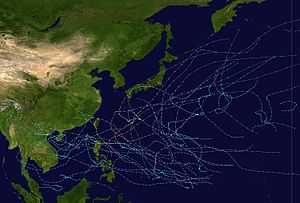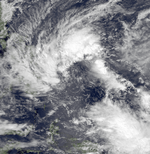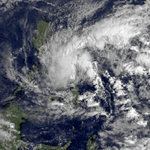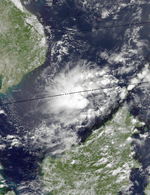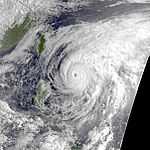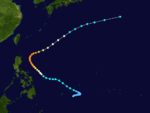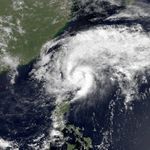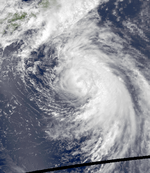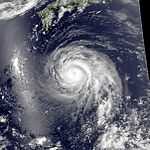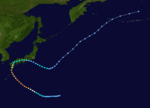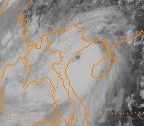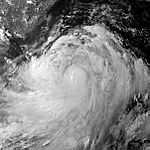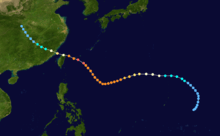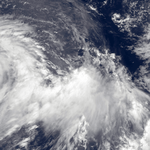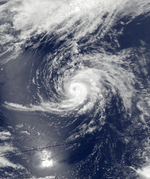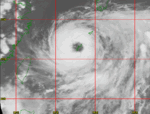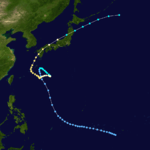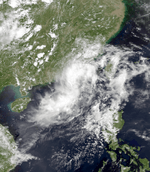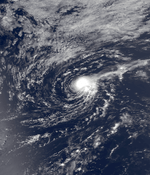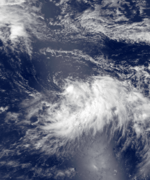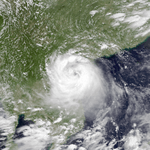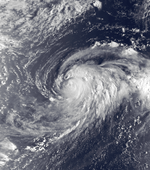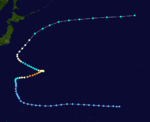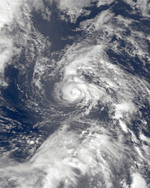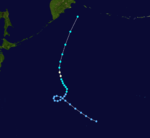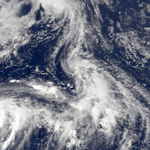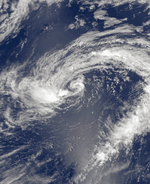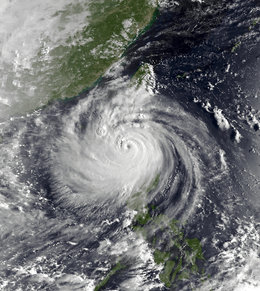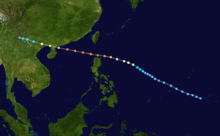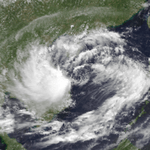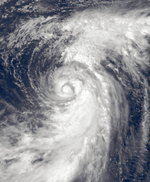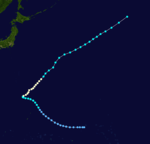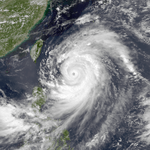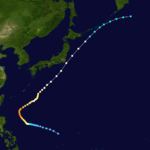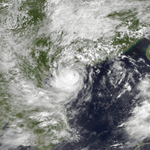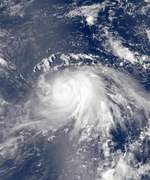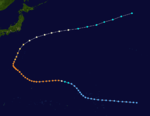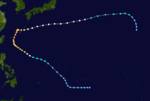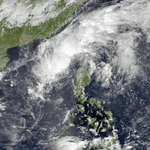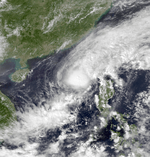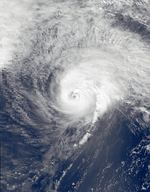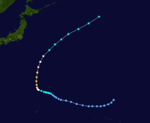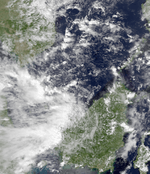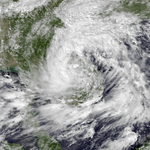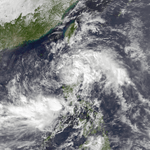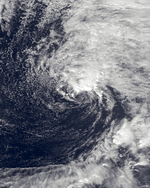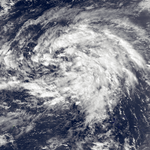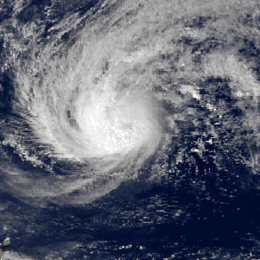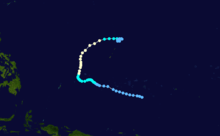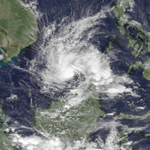1996 Pacific typhoon season
| |
| Season summary map |
| First system formed |
February 24, 1996 |
| Last system dissipated |
December 29, 1996 |
| Strongest storm |
Herb – 925 hPa (mbar), 175 km/h (110 mph) (10-minute sustained) |
| Total depressions |
43 |
| Total storms |
31 |
| Typhoons |
16 |
| Super typhoons |
6 |
| Total fatalities |
873 |
| Total damage |
$6.87 billion (1996 USD) |
Pacific typhoon seasons
1994, 1995, 1996, 1997, 1998 |
The 1996 Pacific typhoon season has no official bounds; it ran year-round in 1996, but most tropical cyclones tend to form in the northwestern Pacific Ocean between May and November.[1] These dates conventionally delimit the period of each year when most tropical cyclones form in the northwestern Pacific Ocean.
The scope of this article is limited to the Pacific Ocean, north of the equator and west of the international date line. Storms that form east of the date line and north of the equator are called hurricanes; see 1996 Pacific hurricane season. Tropical Storms formed in the entire west pacific basin were assigned a name by the Joint Typhoon Warning Center. Tropical depressions in this basin have the "W" suffix added to their number. Tropical depressions that enter or form in the Philippine area of responsibility are assigned a name by the Philippine Atmospheric, Geophysical and Astronomical Services Administration or PAGASA. This can often result in the same storm having two names.
Season summary

Storms
The 1996 season was very active. Forty-three tropical cyclones formed this year, of which 34 became tropical storms. Fifteen storms reached typhoon intensity, of which six reached super typhoon strength.
Tropical Storm 01W (Asiang)
| Tropical storm (JMA) |
| Tropical depression (SSHWS) |
|
|
| Duration |
February 24 – March 2 |
| Peak intensity |
65 km/h (40 mph) (10-min) 998 mbar (hPa) |
On February 23, a large area of convection developed south of the Philippines Sea. The convection developed into a low pressure area and was at first bombarded by wind shear, but conditions soon turned favorable which allowed it to strengthen rapidly on February 27 before becoming a Tropical depression later that day. The JMA upgraded 01W into a Tropical Storm before it drifted over the Philippines on February 29, and weakened slightly due to land interaction.[2][3] On March 1, a cold front brought cold, dry air and vertical wind shear which pushed the system south caused the system's low level circulation center to become exposed. The exposed remnants of 01W continued to drift south, before being completely absorbed by the Intertropical Convergence Zone.
Tropical Storm Ann (Biring)
| Tropical storm (JMA) |
| Tropical storm (SSHWS) |
|
|
| Duration |
March 30 – April 10 |
| Peak intensity |
65 km/h (40 mph) (10-min) 1000 mbar (hPa) |
Tropical Depression 03W
| Tropical depression (SSHWS) |
|
|
| Duration |
April 25 – April 26 |
| Peak intensity |
45 km/h (30 mph) (1-min) 1002 mbar (hPa) |
Typhoon Bart (Konsing)
| Typhoon (JMA) |
| Category 4 typhoon (SSHWS) |
|
|
| Duration |
May 8 – May 18 |
| Peak intensity |
175 km/h (110 mph) (10-min) 930 mbar (hPa) |
Tropical Storm Cam (Ditang)
| Tropical storm (JMA) |
| Tropical storm (SSHWS) |
|
|
| Duration |
May 18 – May 23 |
| Peak intensity |
75 km/h (45 mph) (10-min) 994 mbar (hPa) |
Typhoon Dan
| Typhoon (JMA) |
| Category 1 typhoon (SSHWS) |
|
|
| Duration |
July 5 – July 11 |
| Peak intensity |
120 km/h (75 mph) (10-min) 970 mbar (hPa) |
Super Typhoon Eve
| Typhoon (JMA) |
| Category 5 super typhoon (SSHWS) |
|
|
| Duration |
July 12 – July 19 |
| Peak intensity |
155 km/h (100 mph) (10-min) 940 mbar (hPa) |
A Tropical Upper Tropospheric Trough spawned Tropical Depression 7W on July 10 over the open Western Pacific. It tracked generally west-northwestward, strengthening to a tropical storm on the 14th. On the 15th Eve became a typhoon, which was followed by a period of explosive deepening to a 100 mph Typhoon, with a pressure drop of 40 mb from early on the 15th to early on the 16th. An eyewall replacement cycle weakened Eve to a 95 mph typhoon, but as the outer eyewall contracted, the storm again reached wind speeds of 97 mph before hitting southern Japan on the 18th. Rapidly weakening over the mountains, Eve turned eastward over the islands and the last warning was issued on the 20th. It restrengthened to a tropical storm east of Japan, and continued northeastward until dissipation on the 27th. Eve, despite being a Category 4 at landfall, caused no reported deaths and only 9 injuries.[4]
Typhoon Frankie (Edeng)
| Typhoon (JMA) |
| Category 2 typhoon (SSHWS) |
|
|
| Duration |
July 19 – July 25 |
| Peak intensity |
120 km/h (75 mph) (10-min) 955 mbar (hPa) |
An active monsoon trough over the Western Pacific Ocean developed 3 typhoons; Frankie, Gloria, and Herb. The first, Frankie, developed in the South China Sea on July 19. It tracked west-northwestward and became a tropical storm on the 21st. After crossing the island of Hainan Frankie rapidly intensified to a 100 mph typhoon, 945 millibar over the Gulf of Tonkin. It northern Vietnam on the 23rd, and dissipated 2 days later over China. 104 people were reported killed or missing in association with Frankie, and damage figures are estimated at over $200 million (1996 US Dollars).[4]
Typhoon Gloria (Gloring)
| Typhoon (JMA) |
| Category 2 typhoon (SSHWS) |
|
|
| Duration |
July 19 – July 28 |
| Peak intensity |
120 km/h (75 mph) (10-min) 965 mbar (hPa) |
The same monsoon trough that spawned Frankie also spawned a tropical depression on July 19 east of the Philippines. It headed northwestward, slowly organizing into a tropical storm on the 22nd. The next day Gloria reached typhoon strength, and a day later it reached its peak of 100 mph winds. Gloria brushed the northern coast of the Philippines and turned northward to hit Taiwan on the 26th. After crossing the island and the Taiwan Straight, Gloria hit China where she dissipated on the 27th. Gloria caused 23 casualties, 20 of which were in the northern Philippines. In addition, damage was estimated at $20 million (1996 USD).[4]
Super Typhoon Herb (Huaning)
| Typhoon (JMA) |
| Category 5 super typhoon (SSHWS) |
|
|
| Duration |
July 23 – August 4 |
| Peak intensity |
175 km/h (110 mph) (10-min) 925 mbar (hPa) |
Main article:
Typhoon HerbSuper Typhoon Herb was the strongest and the largest storm of 1996. Herb struck Ryūkyū Islands, Taiwan and People's Republic of China. Maximum sustained winds of the cyclone reached 160 miles per hour (260 km/h) over the open ocean. The system led to 590 casualties and US$5 billion in damage (1996 dollars).[4]
Tropical Storm Ian
| Tropical depression (JMA) |
| Tropical storm (SSHWS) |
|
|
| Duration |
July 27 – July 31 |
| Peak intensity |
55 km/h (35 mph) (10-min) 1002 mbar (hPa) |
Severe Tropical Storm Joy
| Severe tropical storm (JMA) |
| Category 1 typhoon (SSHWS) |
|
|
| Duration |
July 29 – August 6 |
| Peak intensity |
100 km/h (65 mph) (10-min) 980 mbar (hPa) |
Typhoon Kirk (Isang)
| Typhoon (JMA) |
| Category 2 typhoon (SSHWS) |
|
|
| Duration |
July 30 – August 16 |
| Peak intensity |
140 km/h (85 mph) (10-min) 955 mbar (hPa) |
A monsoon depression developed on July 28 over the open Pacific Ocean. It headed northwestward, slowly consolidating to become a tropical storm on the 5th. While south of Japan, Kirk drifted to the southeast and looped back to the west, strengthening to a typhoon on the 8th while looping. It continued slowly northwestward, and while curving to the northeast Kirk reached a peak of 110 mph winds. The typhoon struck southwestern Japan at that intensity on the 14th. It weakened over the country, and dissipated on the 16th over the northern Pacific. Kirk caused heavy flooding, resulting in at least 2 deaths and moderate damage.[4]
Tropical Storm Lisa
| Tropical storm (JMA) |
| Tropical storm (SSHWS) |
|
|
| Duration |
August 4 – August 9 |
| Peak intensity |
75 km/h (45 mph) (10-min) 996 mbar (hPa) |
Tropical Depression 15W
| Tropical depression (SSHWS) |
|
|
| Duration |
August 11 – August 17 |
| Peak intensity |
55 km/h (35 mph) (1-min) 1000 mbar (hPa) |
Tropical Storm Marty
| Tropical depression (JMA) |
| Tropical storm (SSHWS) |
|
|
| Duration |
August 12 – August 15 |
| Peak intensity |
55 km/h (35 mph) (10-min) 998 mbar (hPa) |
The monsoon trough spawned a tropical depression over southern China on August 11. It drifted southwestward, entering the Gulf of Tonkin on the 12th. An extremely small cyclone, it reached tropical storm strength on the 13th and a peak of 60 mph on the 14th. Marty made landfall on the 14th on northern Vietnam, where it dissipated 3 days later. Though small and somewhat weak, Marty managed to cause moderate damage and flooding, amounting to the deaths of 125 with 107 people missing.[4]
Tropical Depression 17W
| Tropical depression (SSHWS) |
|
|
| Duration |
August 13 – August 16 |
| Peak intensity |
55 km/h (35 mph) (1-min) 1000 mbar (hPa) |
Typhoon Niki (Lusing)
| Typhoon (JMA) |
| Category 2 typhoon (SSHWS) |
|
|
| Duration |
August 16 – August 24 |
| Peak intensity |
120 km/h (75 mph) (10-min) 965 mbar (hPa) |
Typhoon Orson
| Typhoon (JMA) |
| Category 4 typhoon (SSHWS) |
|
|
| Duration |
August 20 – September 3 |
| Peak intensity |
140 km/h (85 mph) (10-min) 955 mbar (hPa) |
Tropical Storm Piper
| Tropical storm (JMA) |
| Category 1 typhoon (SSHWS) |
|
|
| Duration |
August 22 – August 26 |
| Peak intensity |
75 km/h (45 mph) (10-min) 996 mbar (hPa) |
Tropical Depression 21W
| Tropical depression (SSHWS) |
|
|
| Duration |
August 25 – August 29 |
| Peak intensity |
45 km/h (30 mph) (1-min) 1002 mbar (hPa) |
Tropical Storm Rick
| Tropical depression (JMA) |
| Tropical storm (SSHWS) |
|
|
| Duration |
August 27 – September 3 |
| Peak intensity |
55 km/h (35 mph) (10-min) 1006 mbar (hPa) |
Super Typhoon Sally (Maring)
| Typhoon (JMA) |
| Category 5 super typhoon (SSHWS) |
|
|
| Duration |
September 2 – September 10 |
| Peak intensity |
155 km/h (100 mph) (10-min) 940 mbar (hPa) |
On September 2, a tropical depression developed well east of the Philippines. It headed west-northwestward, reaching tropical storm strength on the 5th and typhoon strength on the 6th. On the 7th Sally rapidly intensified to a 160 mph Super Typhoon while passing just north of the Philippines. It weakened slightly yet steadily to a 115 mph typhoon over the South China Sea, hitting the Luichow Peninsula of China on the 9th, and dissipated the next day over the country. Sally brought heavy rain and damage to China, causing 114 casualties, 110 people missing, and economic losses estimated at $1.5 billion (1996 USD).[4]
Tropical Storm 24W (Ningning)
| Tropical storm (PAGASA) |
| Tropical storm (SSHWS) |
|
|
| Duration |
September 9 – September 15 |
| Peak intensity |
75 km/h (45 mph) (10-min) 995 mbar (hPa) |
Typhoon Tom
| Typhoon (JMA) |
| Category 1 typhoon (SSHWS) |
|
|
| Duration |
September 11 – September 21 |
| Peak intensity |
130 km/h (80 mph) (10-min) 965 mbar (hPa) |
Super Typhoon Violet (Osang)
| Typhoon (JMA) |
| Category 4 super typhoon (SSHWS) |
|
|
| Duration |
September 11 – September 23 |
| Peak intensity |
165 km/h (105 mph) (10-min) 935 mbar (hPa) |
Severe Tropical Storm Willie
| Severe tropical storm (JMA) |
| Category 1 typhoon (SSHWS) |
|
|
| Duration |
September 16 – September 23 |
| Peak intensity |
100 km/h (65 mph) (10-min) 985 mbar (hPa) |
An active monsoon trough that also developed Typhoons Tom (25W) and Violet (26W) spawned a tropical depression in the Gulf of Tonkin on September 16. It moved counter-clockwise around Hainan Island, becoming a tropical storm on the 17th and a typhoon on the 19th. It crossed the narrow Hainan Strait between Hainan and China, and continued west-southwestward across the Gulf of Tonkin. Willie made landfall on Vietnam on the 22nd, and dissipated the next day. The typhoon resulted in 38 fatalities from flooding.[4]
Super Typhoon Yates (Paring)
| Typhoon (JMA) |
| Category 4 super typhoon (SSHWS) |
|
|
| Duration |
September 19 – October 1 |
| Peak intensity |
165 km/h (105 mph) (10-min) 935 mbar (hPa) |
Typhoon Zane (Reming)
| Typhoon (JMA) |
| Category 3 typhoon (SSHWS) |
|
|
| Duration |
September 23 – October 3 |
| Peak intensity |
150 km/h (90 mph) (10-min) 950 mbar (hPa) |
Tropical Storm Abel (Seniang)
| Tropical depression (JMA) |
| Tropical storm (SSHWS) |
|
|
| Duration |
October 10 – October 17 |
| Peak intensity |
55 km/h (35 mph) (10-min) 1000 mbar (hPa) |
In the Philippines, Abel killed eight people, left seven others missing and caused $4.3 million (1996 USD, $6.4 million 2013 USD[5]) in damages.
Tropical Depression 31W
| Tropical depression (SSHWS) |
|
|
| Duration |
October 13 – October 17 |
| Peak intensity |
45 km/h (30 mph) (1-min) 1002 mbar (hPa) |
Severe Tropical Storm Beth
| Severe tropical storm (JMA) |
| Category 2 typhoon (SSHWS) |
|
|
| Duration |
October 11 – October 22 |
| Peak intensity |
110 km/h (70 mph) (10-min) 975 mbar (hPa) |
Typhoon Carlo
| Typhoon (JMA) |
| Category 3 typhoon (SSHWS) |
|
|
| Duration |
October 20 – October 26 |
| Peak intensity |
130 km/h (80 mph) (10-min) 965 mbar (hPa) |
Tropical Depression 34W
| Tropical depression (SSHWS) |
|
|
| Duration |
October 27 – October 31 |
| Peak intensity |
55 km/h (35 mph) (1-min) 1000 mbar (hPa) |
Tropical Depression 35W
| Tropical depression (HKO) |
| Tropical storm (SSHWS) |
|
|
| Duration |
November 1 – November 3 |
| Peak intensity |
55 km/h (35 mph) (10-min) 996 mbar (hPa) |
35W killed 60 people and caused $138 million in damages.[6]
Super Typhoon Dale (Ulpiang)
| Typhoon (JMA) |
| Category 5 super typhoon (SSHWS) |
|
|
| Duration |
November 4 – November 14 |
| Peak intensity |
165 km/h (105 mph) (10-min) 930 mbar (hPa) |
A cluster of thunderstorm activity formed southeast of Guam on November 2. The system slowly organized, becoming a tropical depression on November 4. Remaining nearly stationary, the depression intensified into a tropical storm late in the day. The cyclone then turned westward, becoming a typhoon by November 7. Late in the day, Dale passed south of Guam bringing winds as high as 74 knots (137 km/h) and high seas which overtopped cliffs 30 metres (98 ft) high. Damage on the island totaled US$3.5 million (1996 dollars.) Continuing to intensify, Dale became a supertyphoon in the Philippine Sea on November 9. On November 10, Dale turned north, recurving east of the Philippines. On November 14, Dale accelerated east-northeast at more than 60 knots (110 km/h) as it became an extratropical cyclone.[4]
Tropical Storm Ernie (Toyang)
| Tropical storm (JMA) |
| Tropical storm (SSHWS) |
|
|
| Duration |
November 4 – November 17 |
| Peak intensity |
75 km/h (45 mph) (10-min) 992 mbar (hPa) |
In the Philippines, Ernie killed 24 people, left 12 others missing and caused $5.1 million in damages.
Tropical Storm 38W
| Tropical storm (SSHWS) |
|
|
| Duration |
November 4 – November 12 |
| Peak intensity |
95 km/h (60 mph) (1-min) 992 mbar (hPa) |
Tropical Depression 39W
| Tropical depression (SSHWS) |
|
|
| Duration |
November 8 – November 9 |
| Peak intensity |
55 km/h (35 mph) (1-min) 1000 mbar (hPa) |
Tropical Depression 40W
| Tropical depression (SSHWS) |
|
|
| Duration |
November 25 – November 30 |
| Peak intensity |
45 km/h (30 mph) (1-min) 1002 mbar (hPa) |
Tropical Depression 41W
| Tropical depression (SSHWS) |
|
|
| Duration |
December 14 – December 20 |
| Peak intensity |
55 km/h (35 mph) (1-min) 1000 mbar (hPa) |
Severe Tropical Storm Fern
| Severe tropical storm (JMA) |
| Category 1 typhoon (SSHWS) |
|
|
| Duration |
December 19 – December 29 |
| Peak intensity |
110 km/h (70 mph) (10-min) 975 mbar (hPa) |
Tropical Storm Greg
| Tropical depression (JMA) |
| Tropical storm (SSHWS) |
|
|
| Duration |
December 21 – December 27 |
| Peak intensity |
45 km/h (30 mph) (10-min) 998 mbar (hPa) |
Two active monsoon troughs that also developed Typhoon Fern and Southern Hemisphere Cyclones Ophelia, Phil, and Fergus spawned Tropical Depression 43W in the South China Sea on December 21. Due to the troughs' nature, the depression headed east-southeastward, where it strengthened into the final tropical storm of the year on the 24th; Greg. After reaching a peak of 45 knots (83 km/h) winds it crossed the northern part of Borneo on the 25th. It continued east-southeastward until dissipation on the 27th, south of the Philippines. Greg caused extensive property damage on Borneo from torrential flooding, resulting in 127 deaths and 100 people missing.[4]
Storm names
In 1996, western North Pacific tropical cyclones were named by the Joint Typhoon Warning Center. The first storm of 1996 was named Ann and the final one was named Greg.
- Ann (9602)
- Bart (9603)
- Cam (9604)
- Dan (9605)
- Eve (9606)
- Frankie (9607)
|
- Gloria (9608)
- Herb (9609)
- Ian
- Joy (9610)
- Kirk (9612)
- Lisa (9611)
|
- Marty
- Niki (9613)
- Orson (9614)
- Piper (9615)
- Rick
- Sally (9616)
|
- Tom (9618)
- Violet (9617)
- Willie (9619)
- Yates (9620)
- Zane (9621)
- Abel
|
- Beth (9622)
- Carlo (9623)
- Dale (9624)
- Ernie (9625)
- Fern (9626)
- Greg
|
|
Philippines
The Philippine Atmospheric, Geophysical and Astronomical Services Administration (PAGASA) uses its own naming scheme for tropical cyclones within its area of responsibility. Lists are recycled every four years. This is the same list used for the 1992 season.
- Asiang
- Biring (9602)
- Konsing (9603)
- Ditang (9604)
- Edeng (9607)
|
|
- Ningning
- Osang (9617)
- Paring (9620)
- Reming (9621)
- Seniang
|
- Toyang (9625)
- Ulpiang (9624)
-
Welpring (unused)
-
Yerling (unused)
-
Aring (unused)
|
-
Basiang (unused)
-
Kayang (unused)
-
Dorang (unused)
-
Enang (unused)
-
Grasing (unused)
|
See also
References
External links
|
|---|
| | | |
-
 Book Book
-
 Category Category
-
 Portal Portal
-
 WikiProject WikiProject
-
 Commons Commons
|
|
| 1990–1999 Pacific typhoon seasons |
|---|
| |
|
